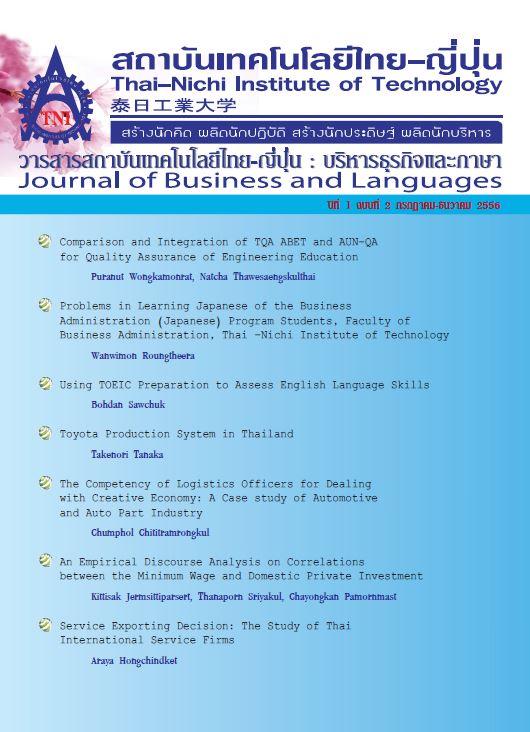An Assessment of English Speaking Ability of Technical and Business Students: A Case of Thai-Nichi Institute of Technology
Main Article Content
Abstract
The purposes of this research were 1) to assess English speaking ability of technical and business students at Thai-Nichi Institute of Technology, 2) to compare the English speaking ability of the students before and after teaching speaking skill in the classroom, and 3) to study opinions of business and technical students at Thai-Nichi Institute of Technology.
Research samples were 72 students at Thai-Nichi Institute of Technology in second semester of 2012 academic year through simple random sampling technique. The instruments used for gathering data were the English speaking skills assessment form and opened-end questionnaire. The statistics employed for analyzing the data were frequency, percentage, mean, standard deviation, t-test, and contents analysis.
The research findings were as following; 1) effects of an assessment of English speaking ability of business and technical students at Thai-Nichi Institute of Technology were at high level, 2) the students’ English speaking achievement after teaching speaking skill was significantly higher than that before teaching speaking skill at 0.05 level, and 3) the students had additional suggestions as follows; Speech contest should be set every semester to improve listening skill, teachers should teach speaking skill both in class and outside class, communication in English should be arranged outside class, and Sightseeing in foreign countries should be managed every year to share cultures and cross cultures.
Article Details
Article Accepting Policy
The editorial board of Thai-Nichi Institute of Technology is pleased to receive articles from lecturers and experts in the fields of business administration, languages, engineering and technology written in Thai or English. The academic work submitted for publication must not be published in any other publication before and must not be under consideration of other journal submissions. Therefore, those interested in participating in the dissemination of work and knowledge can submit their article to the editorial board for further submission to the screening committee to consider publishing in the journal. The articles that can be published include solely research articles. Interested persons can prepare their articles by reviewing recommendations for article authors.
Copyright infringement is solely the responsibility of the author(s) of the article. Articles that have been published must be screened and reviewed for quality from qualified experts approved by the editorial board.
The text that appears within each article published in this research journal is a personal opinion of each author, nothing related to Thai-Nichi Institute of Technology, and other faculty members in the institution in any way. Responsibilities and accuracy for the content of each article are owned by each author. If there is any mistake, each author will be responsible for his/her own article(s).
The editorial board reserves the right not to bring any content, views or comments of articles in the Journal of Thai-Nichi Institute of Technology to publish before receiving permission from the authorized author(s) in writing. The published work is the copyright of the Journal of Thai-Nichi Institute of Technology.
References
Burns, A. (2003). Clearly speaking : pronunciation in action for teachers. National Center for English Language Teaching and Research, Macquaire Universaity, Sydney NSW 2109.
Burns, A., & Joyce, H. (1997). Focus on speaking. North Ryde, N.S.W.: National Center for English Language Teaching and Research.
Richards, J., & Renandya, W. (2002). Methodology in language teaching. Cambridge: Cambridge University Press.
Carter, R., & McCarthy, M. (1995). Grammar and spoken language, Applied Linguistics, 16 (2), 141-158.
Cohen, A. (1996). Developing the ability to perform speech acts, Studies in Second Language Acquisition, 18 (2), 145-148.
Stone, Lee Ann. (1991) Task-based activities: Making the language laboratory interactive. Retrieved from: (ERIC Document Reproduction Service No. 25 (3), 81-86
Henning, G. (1987). A guide to language testing: Development, evaluation, research. Boston: Heinle & Heinle Publishers.
Kitao, S.K., & Kitao, K. (1996). Testing speaking. Retrieved from: (ERIC Document Re eproduction Service No. ED 398261), 1-7
Spolsky, B. (1992). Diagnostic testing revisited. In Shohamy, E. and Walton, R. A., (Eds.), Language assessment and feedback: Testing and other strategies (pp 29-39). Dubuque, IA: Kendall/Hunt Publishing Company
Best, Johnson W. (1981). Research in Education. 5th ed. New Jersey: Prentice-Hall Inc.
Dornyei, Z. (2003a). Attitudes, orientations, and motivations in language learning: Advances in theory, research, and applications. Language Learning, 53(1), 3–32. ED 343407).
Quinn, R.A. (1994). Opening the doors of the language laboratory: New perspectives and opportunities, ADFL Bulletin,


